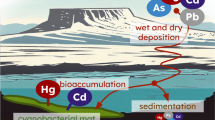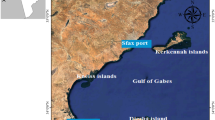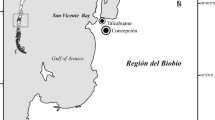Abstract
In situ interactions between cyanobacteria and metals were studied at Torrão reservoir (Tâmega River, North Portugal). The metal content of water and sediments from the reservoir was monitored monthly at Marco de Canaveses (seasonally subjected to toxic blooms of Microcystis aeruginosa) and upstream at Amarante (no blooms recorded), for 16 months. During the 16 months of the study period, M. aeruginosa bloomed twice at Marco de Canaveses, firstly forming a scum, and later with colonies scattered throughout the reservoir. Metals Cd, Co, Cr, Cu, Fe, Mn, Ni, Pb and Zn were analysed in the sediment and in the water column. Cu-binding ligands in water were also determined. When no blooms were taking place, average metal levels for water and sediment were not statistically different at both locations. Therefore, it was considered that the absence of cyanobacteria blooms at Amarante was not due to differences in metal content. When blooms were taking place at Marco de Canaveses, a significant increase of metal levels in the sediment occurred simultaneously. Sediment quality guidelines showed that during this period, Cu and Pb concentrations (32.3 and 43.2 mg kg−1, respectively) were potentially toxic. However, quantification of the exchangeable metal fraction indicated that these metals were probably not bioavailable. Concentration of Cu-binding ligands in water was higher during the blooms, indicating that cyanobacteria are capable of changing the metal speciation in situ in a reservoir.




Similar content being viewed by others
References
Masango M, Myburgh J, Botha C, Labuschagne L, Naicker D (2008) A comparison of in vivo and in vitro assays to assess the toxicity of algal blooms. Water Res 42:3241–3248
Paerl HW, Hall NS, Calandrino ES (2011) Controlling harmful cyanobacterial blooms in a world experiencing anthropogenic and climatic-induced change. Sci Total Environ 409:1739–1745
Kanoshina I, Lips U, Leppänen JM (2003) The influence of weather conditions (temperature and wind) on cyanobacterial bloom development in the Gulf of Finland (BalticSea). Harmful Algae 2:29–41
Ye L, Wu X, Tan X, Shi X, Li D, Yu Y, Zhang M, Kong F (2010) Celllysis of cyanobacteria and its implications for nutrient dynamics. Int Rev Hydrobiol 95:235–245
Guven B, Howard A (2006) Modelling the growth and movement of cyanobacteria in river systems. Sci Total Environ 368:898–908
Baptista MS, Vasconcelos MT (2006) Cyanobacteria metal interactions: requirements, toxicity and ecological implications. Crit Rev Microbiol 32:127–137
Heng LY, Jusoh K, Ling CHM, Idri M (2004) Toxicity of single and combinations of lead and cadmium to the cyanobacteria Anabaenaflos-aquae. Bull Environ Contam Toxicol 72:373–379
García-Villada L, Rico M, Altamirano M, Sánchez-Martín L, López-Rodas V, Costas E (2004) Occurrence of copper resistant mutants in the toxic cyanobacteria Microcystis aeruginosa: characterisation and future implications in the use of copper sulphate as algaecide. Water Res 38:2207–2213
Yee N, Benning GL, Phoenix VR, Ferris FG (2004) Characterization of metal-cyanobacteria sorption reactions: a combined macroscopic and infrared spectroscopic investigation. Environ Sci Technol 238:775–782
Gouvêa SP, Vieira AAH, Lombardi AT (2005) Copper and cadmium complexation by high molecular weight materials of dominant microalgae and of water from a eutrophic reservoir. Chemosphere 60:1332–1339
Tsujimura S, Tsukada H, Nakahara H, Nakajima T, Nishino M (2000) Seasonal variations of Microcystis populations in sediments of Lake Biwa, Japan. Hydrobiologia 434:183–192
Hu J, Shen Q, Liu Y, Liu J (2007) Mobility of different phosphorus pools in the sediment of Lake Dianchi during cyanobacterial blooms. Environ Monit Assess 132:141–153
García-Hernández J, García-Rico L, Jara-Marini ME, Barraza-Guardado R, Weaver AH (2005) Concentrations of heavy metals in sediment and organisms during a harmful algal bloom (HAB) at Kun Kaak Bay, Sonora, Mexico. Mar Pollut Bull 50:733–739
Martins J, Saker ML, Moreira C, Welker M, Fastner J, Vasconcelos VM (2009) Peptide diversity in strains of the cyanobacterium Microcystis aeruginosa isolated from Portuguese water supplies. Appl Microbiol Biotechnol 82:951–961
Saker ML, Fastner J, Dittmann E, Christiansen G, Vasconcelos VM (2005) Variation between strains of the cyanobacterium Microcystis aeruginosa isolated from a Portuguese river. J Appl Microbiol 99:749–757
Strickland JDH, Parsons TR (1972) A practical handbook of seawater analysis. 2nd edition, Bulletin 167. FisheriesResearchBoard of Canada, Ottawa
US Environmental Protection Agency (1994) Method 3051: microwave assisted acid digestion of sediments, sludges, soils, and oils. Washington D.C
Almeida CM, Mucha AP, Vasconcelos MT (2004) Influence of the sea rush Juncus maritimus on metal concentration and speciation in estuarine sediment colonized by the plant. Environ Sci Technol 38:3112–3118
Rauret G, López-Sánchez JF, Sahuquillo A, Rubio R, Davidson C, Ure A, Quevauviller P (1999) Improvement of the BCR three step sequential extraction procedure prior to the certification of the new sediment and soil reference materials. J Environ Monit 1:57–61
Vasconcelos MTSD, Leal MFC (2001) Adsorption and uptake of Cu by Emiliania huxleyi in natural seawater. Environ Sci Technol 35:508–515
Turner DR, Whitfield M, Dickson AG (1981) The equilibrium speciation of dissolved components in freshwater and seawater at 25 ºC and 1 atm pressure. Geochim Cosmochim Acta 45:855–882
Campos MLAM, van den Berg CMG (1994) Determination of copper complexation in seawater by cathodic stripping voltammetry and ligand competition with salicylaldoxime. Anal Chim Acta 284:481–496
Huber-Pestalozi G (1938) Dasphytoplakton des susswassers 1. Allgemeiner Teil. Blaualgen, bakterien, pilze. Die binnengewässer XVI. E. Schweizerbart’scheVerlagsbuchhandlung, Stuttgard
Bourrely P (1970) Les algues d’eau douce. Tome III: Eugléniens, péridiniens, algues rouges, algues bleues. Éditions N. Boubée& Cie, Paris
Oliver RL, Ganf GG (2000) Freshwater blooms. In: Whitton BA, Potts M (eds) The ecology of cyanobacteria. Kluwer AcademicPublishers, Dordrecht, pp 149–194
MacDonald DD, Ingersoll CG, Berger TA (2000) Development and evaluation of consensus-based Sediment Quality Guidelines for freshwater ecosystems. Arch Environ Contam Toxicol 39:20–31
Hamilton-Taylor J, Smit EJ, Davison W, Sugiyama M (2005) Resolving and modeling the effects of Fe and Mn redox cycling on trace metal behavior in a seasonally anoxic lake. Geochim Cosmochim Acta 69:1947–1960
Matthew J, Harke MJ, Berry DL (2012) Molecular response of the bloom-forming cyanobacterium, Microcystis aeruginosa, to phosphorus limitation. Microb Ecol 63:188–198
Achteberg EP, van den Berg CMG, Boussemart M, Davison W (1997) Speciation and cycling of trace metals in Esthwaite Water: a productive English lake with seasonal deep-water anoxia. Geochim Cosmochim Acta 61:5233–5253
Warren LA, Haack EA (2001) Biogeochemical controls on metal behaviour in freshwater environments. Earth Sci Rev 54:261–320
Hoffmann SR, Shafer MM, Armstrong DE (2007) Strong colloidal and dissolved organic ligands binding copper and zinc in rivers. Environ Sci Technol 41:6996–7002
Henderson RK, Baker A, Parsons SA, Jefferson B (2008) Characterisation of algogenic organic matter extracted from cyanobacteria, green algae and diatoms. Water Res 42:3435–3445
Acknowledgments
The authors acknowledge Micaela Vale and Ana Paula Mucha for their help with laboratory work and the fireman from Marco de Canaveses for their help with the water sampling. This work was partially funded by Fundaçãopara a Ciência e a Tecnologia (FCT), Portugal, through a fellowship awarded to Mafalda Baptista (SFRH/BPD/44373/2008) and the project PEst-C/MAR/LA0015/2013.
Author information
Authors and Affiliations
Corresponding author
Rights and permissions
About this article
Cite this article
Baptista, M.S., Vasconcelos, V.M. & Vasconcelos, M.T.S.D. Trace Metal Concentration in a Temperate Freshwater Reservoir Seasonally Subjected to Blooms of Toxin-Producing Cyanobacteria. Microb Ecol 68, 671–678 (2014). https://doi.org/10.1007/s00248-014-0454-x
Received:
Accepted:
Published:
Issue Date:
DOI: https://doi.org/10.1007/s00248-014-0454-x




